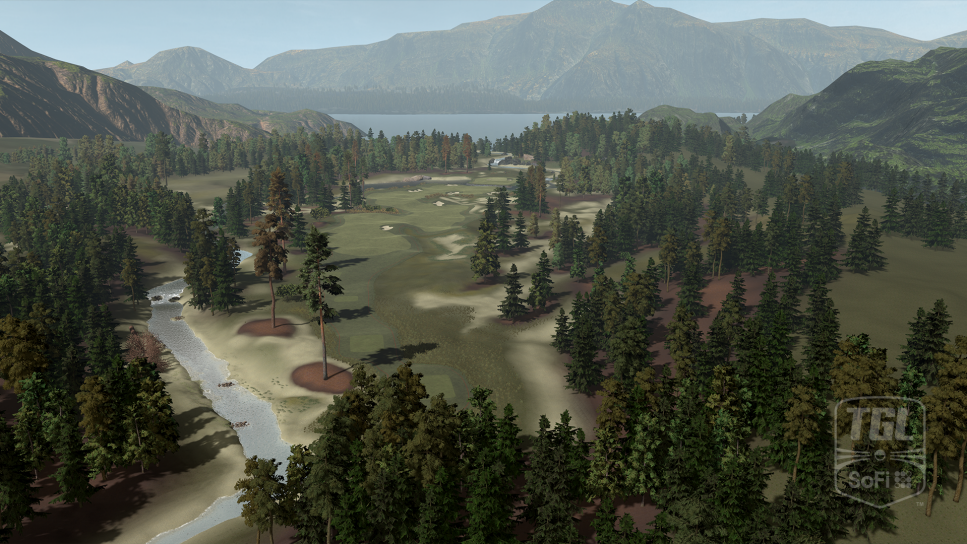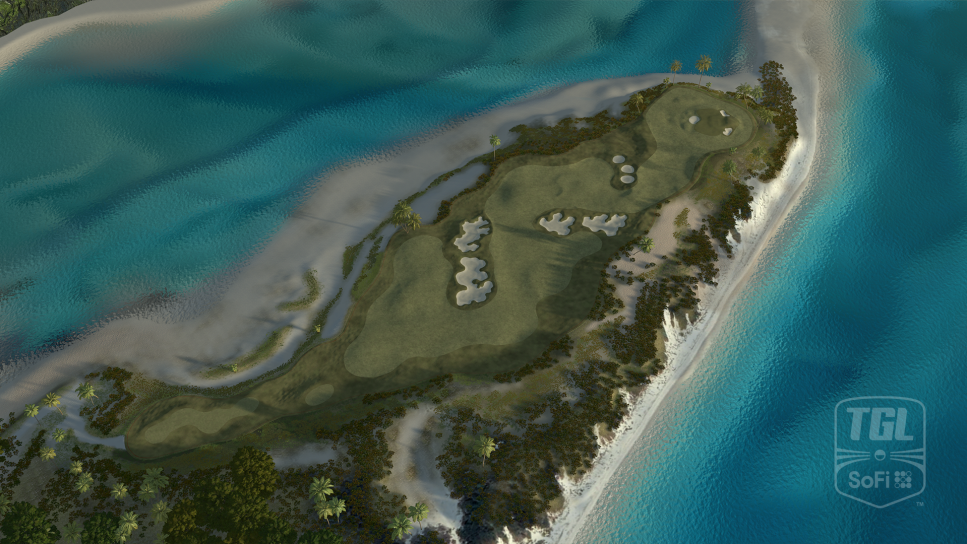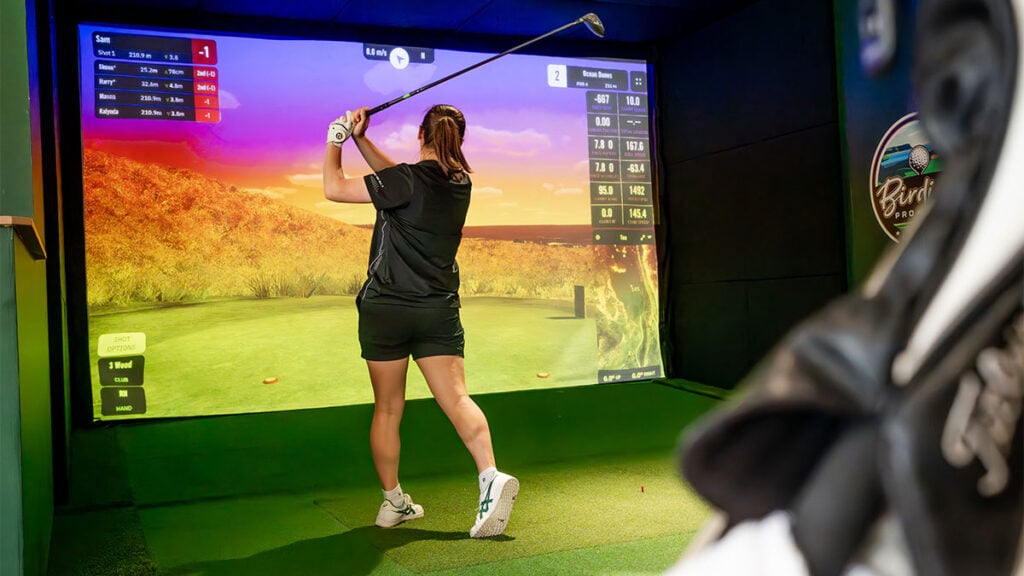Seven questions you probably still have about golf’s new simulator league hitting our screens this month.
Part simulator, part real golf. Broadcast in Australia on Fox Sports and Kayo. A collapsed stadium. Adam Scott and Min Woo Lee representing different teams. Hundreds of millions of dollars in investment from A-listers like Stephen Curry, Serena Williams and Justin Timberlake.
You may have heard brief rumblings and team announcements, but chances are your understanding of TGL – the primetime golf league scheduled to debut on January 8 – is still a little fuzzy.
The nascent golf league is the creation of TMRW Sports, the venture led by Tiger Woods, Rory McIlroy and sports executive Mike McCarley, in partnership with the PGA Tour in what is widely understood as a counter to the Saudi-backed LIV Golf’s team-golf-in-a-fun-atmosphere appeal.
The stakes are high. If it works, TGL is positioned to capitalise on golf’s growing popularity with casual sports fans and usurp LIV’s claim to captivating team golf. If it fails, millions in investment will be wasted, and perhaps worse, professional golf’s identity crisis in the wake of its schism may further alienate fans who simply want the old status quo of the best players competing over 72 holes on a real course on a consistent basis.
As the new league prepares to start, we have details on the format, tech-infused stadium and the bold, digital-first hole designs created by world-class architects. You’ve got lots of questions, we’ve got some answers. Here’s what we know.
▶ ▶ ▶
Wait a minute, wasn’t this league supposed to start last year?
Yep, TGL was originally slated for a January 2024 launch until November 2023, when the stadium’s roof collapsed. In retrospect, it was fortuitous timing, as the extra year allowed organisers the time to redesign a new, sturdier stadium in Palm Beach Gardens, Florida, and further refine the league’s launch.

▶ ▶ ▶
OK, so when is it, who’s playing and for how much money?
The first match will be played on Wednesday, January 8 (Australian time), and will be aired live on Fox Sports/Kayo. The second match will be played a week later on January 15, followed by the third match on Wednesday, January 22, both of which will be aired live. The schedule then runs approximately weekly until the first week in March.
The league consists of six teams of four PGA Tour players. The players combine for more than 200 PGA Tour wins and more than 30 major championship victories. Prior to the original planned launch earlier, McCarley (the league’s co-founder) said the total purse would be $US21 million, with $US9 million going to the season’s winning team.
Atlanta Drive Golf Club: Lucas Glover, Patrick Cantlay, Justin Thomas, Billy Horschel.
Boston Common Golf: Keegan Bradley, Rory McIlroy, Hideki Matsuyama,
Adam Scott.
Jupiter Links Golf Club: Tom Kim, Tiger Woods, Max Homa, Kevin Kisner.
Los Angeles Golf Club: Sahith Theegala, Tommy Fleetwood, Collin Morikawa, Justin Rose.
New York Golf Club: Matt Fitzpatrick, Rickie Fowler, Xander Schauffele, Cameron Young.
The Bay Golf Club: Min Woo Lee, Wyndham Clark, Ludvig Aberg,
Shane Lowry.
▶ ▶ ▶
What about all of those big-name investors?
Like other sports leagues, TGL teams have private ownership, including from some of the most prominent names in major league sports. Similar to LIV Golf’s team franchising model, TGL teams will have stakes in the league’s overall success.
Atlanta Drive Golf Club: Prominent investors include Arthur M. Blank of AMB Sports and Entertainment, which has ownership in the Atlanta Falcons and Atlanta United.
Boston Common Golf: Investors include John Henry, Tom Werner, Mike Gordon, and Fenway Sports Group, who own the Boston Red Sox, Liverpool FC, Pittsburgh Penguins and RFK Racing.
Jupiter Links Golf Club: Tiger Woods’ TGR Ventures and David Blitzer, who has ownership in the Philadelphia 76ers, New Jersey Devils, Cleveland Guardians, Washington Commanders, Crystal Palace FC, Real Salt Lake, Utah Royals and Joe Gibbs Racing.
Los Angeles Golf Club: Investors include Alexis Ohanian (Angel City FC), Serena and Venus Williams, as well as smaller stakes held by the Antetokounmpo brothers, Alex Morgan, Servando Carrasco and Michelle Wie West.
New York Golf Club: Investors include Steven A. Cohen, whose Cohen Private Ventures has ownership stake in the New York Mets, plus New York sports legends Derek Jeter, Eli Manning, Michael Strahan and CC Sabathia.
The Bay Golf Club: Owned by a group led by Avenue Sports Fund with Stephen Curry and Marc Lasry, as well as Andre Iguodala and Klay Thompson.
▶ ▶ ▶
How does the format work?
Teams will play head-to-head in a 15-hole match. The match will be divided into two sessions. Session 1, on holes one to nine, will be ‘triples’ in which three players on a team play foursomes (alternate shot). Session 2, on holes 10-15, will be ‘singles’ in which players will compete one-on-one.
A team will earn one point for winning a hole and if teams tie, no points will be given. There are no carryovers. The team with the most points at the end of 15 holes will be the winner. In the case of a tie, the match will be decided in overtime in a 3-vs-3 closest-to-the-hole competition.
There is a clever twist with the ‘hammer’, common among weekend money games. In TGL, if a team wants to raise the stakes on a hole, they can ‘throw’ the hammer. If the other team accepts, it raises the stakes of the hole by one point. If the opposing team declines the hammer, they concede the hole. The hammer rotates from team to team, allowing for quick comebacks.
There will also be a 40-second shot clock, limited timeouts and referees on the field, all making TGL feel fast-paced and closer to a typical stadium sport.
There will be a season-long competition among the six teams. Teams will earn two points for a match win, one point for a loss in overtime and no points for a loss in regulation. The top four teams in the season standings will advance to the finals, which will include single-elimination semi-finals and a best-of-three championship.

▶ ▶ ▶
I’ve heard there’s a lot of tech involved. Is this simulator golf or real golf?
Yes, yes and yes. TGL is a sort of tech-infused hybrid of simulator and real-world golf. The matches will be played in the 23,000 square-metre SoFi Center, which will seat 1,500 fans and house a huge simulator screen that is 16 metres tall and 20 metres wide – nearly 24 times larger than a standard simulator.

The entire field of play is 89 metres long, 46 metres wide and includes two real-grass tees and a Greenzone the size of four basketball courts.

To start a hole, players will hit into the screen from the tee 32 metres away. Teams will continue to hit into the screen until their ball finishes inside the boundary of the Greenzone, after which players will turn around and begin playing on the real grass putting surface and green surrounds. The tees include fairway-cut grass, rough and real sand for bunker shots. Around the green players will be able to hit real chips and pitches as well as bunker shots from three bunkers.
▶ ▶ ▶
So is every hole going to have the same green?
No, and this is where TGL hopes to really distances itself from any other simulator-only game. The golf simulator company Full Swing created a green with 600 actuators that can change undulations in just five seconds, allowing the surface to play quite different from hole to hole. What’s more, the entire green and bunker platform rotates 360 degrees, allowing for approaches to come into the green at different angles on different holes. As a result, each hole will be unique just as it would be in real golf.

▶ ▶ ▶
What about those holes, are they going to be playing existing holes or new ones?
TGL will consist of a collection of about 30 original holes designed specifically for the league by three top architects – Tiger Woods’ long-time design partner Beau Welling, the Nicklaus Design firm and one of Latin America’s top architects Augustín Pizá.
Pizá has worked on more than 70 course projects across three continents – many of which in Latin America – and has collaborated with Jack Nicklaus, Tom Fazio, Robert von Hagge, Gary Player and others. Being able to design holes with no environmental or monetary restraints was liberating, says Pizá, but it also created new challenges.
“It is a blank canvas. We can do whatever we want,” says Pizá, who earned his master’s degree in golf course architecture from the University of Edinburgh. “Now that is also the challenge because when you have this liberty, you have to design something exciting, something different, something challenging, something beautiful, but also respecting the integrity of the game.”

After agreeing to create a batch of holes for TGL, Pizá first started with pencil and paper, as he would for any green-grass course. Next, instead of worrying about where irrigation would go and what the terrain dictates, Pizá had to create the terrain himself. Each TGL plays in a unique landscape, from oceanside to desert to mountains.
“My thought process was to create something that you could still do in real life, but we can’t really do it because of constraints like budget or environmental or timing,” Pizá says. “But there would be a world that you can do it.”
After creating detailed sketches, Pizá worked closely with digital shapers at Full Swing to bring his vision to simulator reality.
▶ ▶ ▶




Are they going to be playing existing holes or new ones?
TGL will consist of a collection of about 30 original holes designed specifically for the league by three top architects – Tiger Woods’ long-time design partner Beau Welling, the Nicklaus Design firm and one of Latin America’s top architects Augustin Pizá.
Pizá has worked on more than 70 course projects across three continents – many of which are in Latin America – and has collaborated with Jack Nicklaus, Tom Fazio, Robert von Hagge, Gary Player and others. Being able to design holes with no environmental or monetary restraints was liberating, says Pizá, but it also created new challenges.
“It is a blank canvas. We can do whatever we want,” says Pizá, who earned his master’s degree in golf course architecture from the University of Edinburgh. “Now that is also the challenge because when you have this liberty, you have to design something exciting, something different, something challenging, something beautiful, but also respecting the integrity of the game.”
After agreeing to create a batch of holes for TGL, Pizá first started with pencil and paper, as he would for any green-grass course. Next, instead of worrying about where irrigation would go and what the terrain dictates, Pizá had to create the terrain himself. Each TGL plays in a unique landscape, from oceanside to desert to mountains.
“My thought process was to create something that you could still do in real life, but we can’t really do it because of constraints like budget or environmental or timing,” Pizá says. “But there would be a world that you can do it.”
After creating detailed sketches, Pizá worked closely with digital shapers at Full Swing to bring his vision to simulator reality.






